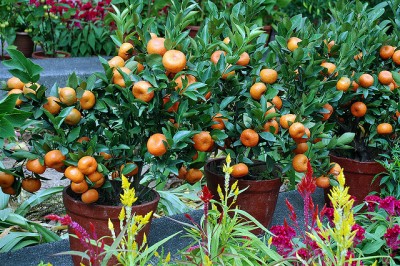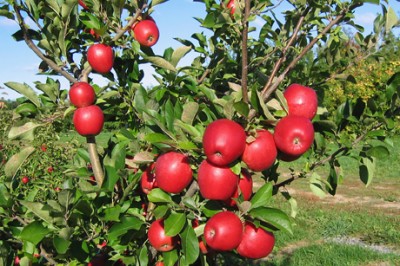 There’s something infinitely satisfying about growing your own food. One great thing about growing fruit is that you can eat it straight from the tree. Once planted, you can literally await the “fruits” of you labor, and then enjoy them year after year.
There’s something infinitely satisfying about growing your own food. One great thing about growing fruit is that you can eat it straight from the tree. Once planted, you can literally await the “fruits” of you labor, and then enjoy them year after year.
With the new varieties of compact fruit trees, you don’t even need a lot of space to grow fruit trees. You can have them on your patio or even on the balcony of apartments. Not all fruit trees are suitable for small spaces, though. There are several cultivars that are specially developed for maximizing yield in limited space.
Besides apples and pears, there are several stone fruits like plums, peaches, cherries and nectarines to choose from. Of the citrus family, Calamondin orange, Kumquats and Meyer lemon are very popular as patio trees. Blueberries, raspberries and even mulberries can be grown in the balcony or patio to provide you bushels of fruit.
Try these different types of patio trees:
- Dwarf trees.These are a selected variety of scions grafted onto special dwarf rootstock. They maintain the natural shape of the tree, albeit in a smaller scale. You can choose from dwarf cultivars of stone fruits such as cherries, peaches and plums or you can go for dwarf figs, pears and apples.
- Columnar trees.Columnar fruit trees are developed to grow in a narrow column, reaching 6 to 8 feet in height. Instead of sending out long side branches, these trees set fruit on the main vertical stem which carries short spurs. You can plant a row of them to do double duty as a privacy screen. They need only 3 feet of clearance between them. Columnar apple trees are very popular, but cherries, plums and pears are also available.
Order your 2014 Heirloom Solutions seed catalog and get $20 in your account!
- Container-restricted trees.They are normal fruit trees planted in containers. The size of the container and frequent selective pruning keep them within desired dimensions. They grow into dwarf trees much like bonsai trees. It might have been a way to carry the trees along when people moved, but the advent of dwarf and columnar varieties has made them redundant.
- Espaliers.It was a traditional practice to grow trees espaliered against a wall to get maximum yield in minimum space. It’s an effort spanning several years to train an espalier with just the desirable branches remaining on the tree. Hobbyists still experiment with this art.
Choosing the right container for patio fruit trees
- Terracotta pots. With porous walls, terracotta pots are the nearest to the natural habitat of plants. They are heavy enough to counterbalance the crowns of top-heavy trees. But they will require frequent watering due to the higher rate of evaporation from the clay walls. They are not very portable either. If you plan to keep your fruit trees in terracotta pots, have a strong base on casters so that moving them about would be easier.
- Wooden barrels and boxes. Wooden barrels are charming, and may go very well with your landscape, but even with a good sealant, they may eventually rot. Boxes made of naturally long-lasting wood like the cedar may be a better bet. It would be more practical to have a non-permeable liner inside.
- Plastic pots. Plastic pots are light-weight and long-lasting, but tend to heat up in summer. But portability and easy availability in all shapes and sizes make them a popular choice for fruit trees. Keeping them inside a wooden barrel or box will solve the problem of heating up, too. Proper drainage is very important in plastic pots.
Potting soil for patio fruit trees

Image course: news.cornell.edu
Since the pots are going to be the home of these trees for a long time, the soil should contain plenty of humus which will provide continuous nutrition to them. Mix in good quality compost. Incorporate a long-release fertilizer such as bone meal or fish emulsion into the soil. It goes without saying that the soil should be well-draining as no self-respecting fruit tree would like to have wet feet. The trees may need repotting once every three years, or sooner, depending on their growth.
Keeping the patio fruit trees in good shape
- Pest Control. Even though many varieties are developed for their disease resistance, they are not immune to bacterial and fungal diseases. You may come across pests too, but chemical pesticides are out of question for two reasons. Part of those chemicals may get into the fruits for one thing. The trees themselves are too close for comfort, too. But being in close proximity, it’s easier to spot the infestations before they become unmanageable. A strong spray of water should take care of most of the pets. Aphids and scales brought in by ants can be avoided by keeping the pots inside a tray filled with water. The pots should be slightly raised on bricks so that they don’t actually sit in the water, though. An effective organic pesticide is neem oil. Mix it with diluted soap solution and spray to soak the plant and the soil.
- Fertilizing. Frequent fertilization is necessary as the patio fruit trees in pots cannot send out their roots to gather the required nutrients from far and wide. Along with high-nitrogen fertilizers applied fortnightly, you should ensure they get a steady supply of micronutrients, too. Once they are mature, they may need extra potassium for fruit bearing. Check the pH of the soil and add lime if it is less than 6. Blueberries love more acidity, though.
- Overwintering. If the winters are mild, many trees in pots will survive on the patio or balcony without much incident. If flowers appear too early in the spring, they may need protection to avoid frost damage. Cover them up with a plastic sheet or move them to a garage temporarily. Do not bring them into a heated house, though; it may disrupt their flowering cycle.
- Pollination. High rates of pollination ensures good yield. Some trees are self-pollinating but others need more than one tree of the same species for cross-pollination. Ensure that pollinators have access to the flowers even when you protect early spring-flowering trees from frost by covering them up.
- Pruning. Only light pruning may be required to keep the patio fruit trees in good shape. Some, like the columnar cultivars, do not need any pruning at all. However, if you see signs of disease or rot on any branch, it should be removed immediately by cutting just above a node. Container-restricted trees may need hard pruning to maintain their size and to promote flowering.
When the trees set fruit, you may notice an overabundance which can be harmful to them in the long run. Thinning out some of the fruit will ensure larger fruit while protecting the trees from exhaustion.
Why you should grow patio fruit trees
- Because you can. With all these dwarf and columnar cultivars available, lack of space is no excuse.
- Because they are healthier. Homegrown fruits are better than those bought from the shop. Fresh fruits have all the healthful vitamins and antioxidants; they lose many nutrients during transport and storage.
- Because they add color and interest. Fruit trees are equally beautiful when they are in flower. Many have colorful autumn leaves, too.
- Because they make good gifts. A basket of fruit from your patio fruit trees makes an ideal gift for any occasion.
Sign up for Off The Grid News’ weekly email and stay informed about the issues important to you
 Off The Grid News Better Ideas For Off The Grid Living
Off The Grid News Better Ideas For Off The Grid Living




